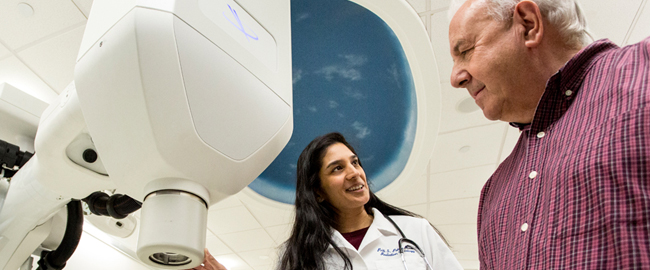Stereotactic Radiosurgery (SRS) and Stereotactic Radiobody Treatment (SBRT) in New Jersey
Stereotactic Radiosurgery (SRS) is a specialized form of radiation therapy that delivers a high dose of radiation to a small, targeted tumor area. Despite the name, SRS is not surgery. It’s typically used to treat tumors in the brain, while Stereotactic Radiobody Therapy (SBRT) refers to the same treatment applied to tumors in other parts of the body. Both SRS and SBRT utilize hundreds of highly focused radiation beams to precisely target and destroy tumor cells.
Compared to conventional radiation therapy, SRS and SBRT can offer better outcomes with fewer side effects due to the highly precise, smaller radiation beams. Treatment can often be completed in just one to five sessions, reducing the treatment burden on patients.
How SRS and SBRT Work
SRS and SBRT work by damaging the DNA of tumor cells, rendering them unable to reproduce. This ultimately leads to the destruction of the cancer cells. Both techniques allow for the delivery of high-dose radiation with remarkable accuracy, minimizing damage to surrounding healthy tissues. In cases of brain tumors, this precision can help preserve cognitive function while delivering effective treatment.Who is a Candidate for SRS or SBRT?
SRS and SBRT are ideal for targeting and treating tumors that are difficult to reach or considered inoperable. They are commonly used for:
- Kidney cancer
- Liver cancer
- Lung cancer
- Malignant and benign tumors and lesions in the brain and other parts of the body
- Nervous system tumors
- Pancreatic cancer
- Prostate cancer
Not all patients are candidates for SRS or SBRT. Your care team will assess your condition to determine whether these advanced radiation therapies are the best option for your treatment.
Why Choose SRS and SBRT at Hackensack Meridian Health?
At Hackensack Meridian Health, our radiation oncology specialists use the most advanced technology to deliver SRS and SBRT treatments, providing patients with the highest level of precision and care. These treatments are ideal for targeting tumors in sensitive areas, such as the brain, and can significantly reduce the side effects compared to traditional radiation therapy.Frequently Asked Questions
The primary advantages of SRS and SBRT include:
- Higher Precision: The treatment precisely targets the tumor, minimizing damage to surrounding healthy tissue.
- Fewer Side Effects: Due to its accuracy, patients often experience fewer side effects.
- Shorter Treatment Course: Treatment can often be completed in just one to five sessions, which is significantly shorter than conventional radiation therapy.
These treatments are ideal for targeting tumors that are difficult to reach or considered inoperable. They are commonly used for a variety of cancers, including:
- Kidney cancer
- Liver cancer
- Lung cancer
- Pancreatic cancer
- Prostate cancer
- Malignant and benign tumors in the brain and nervous system










